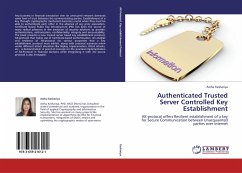Any business or financial transaction over an unsecured network demands some level of trust between the communicating parties. Establishment of a key through cryptographic mechanism becomes crucial when they must be able to authenticate each other in the absence of any prior association. Certificate based Public Key Infrastructure (PKI) has been the source of many radical advances in the evolution of security solutions to provide: authentication, authorization, confidentiality, integrity and accountability. The book presents a new trusted server based key establishment protocol, AK-protocol that makes use of Certificate-based authentication. An analysis and resilience of AK-protocol for various properties that a key establishment protocol must exhibit, along with practical scenarios when under different attack situations like Replay, Impersonation, DDoS attacks, etc., is demonstrated. A proof-of-concept on the practical implementation of AK-Protocol in financial domains while integrating it with 3-D secure protocol is also envisaged.
Bitte wählen Sie Ihr Anliegen aus.
Rechnungen
Retourenschein anfordern
Bestellstatus
Storno








